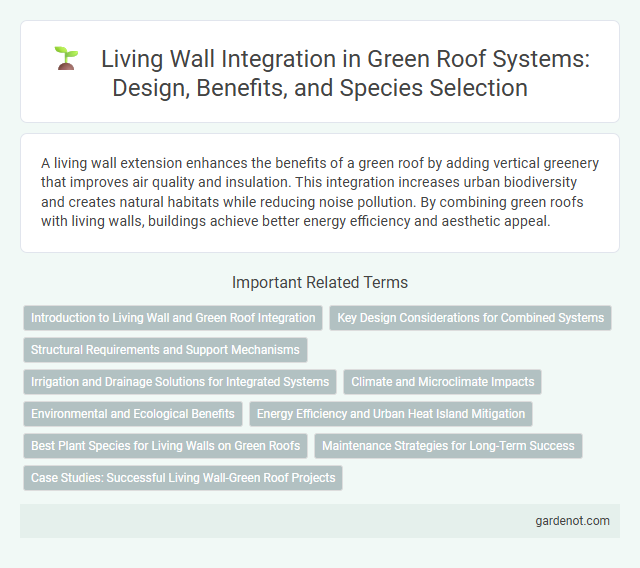A living wall extension enhances the benefits of a green roof by adding vertical greenery that improves air quality and insulation. This integration increases urban biodiversity and creates natural habitats while reducing noise pollution. By combining green roofs with living walls, buildings achieve better energy efficiency and aesthetic appeal.
Introduction to Living Wall and Green Roof Integration
Living walls complement green roofs by extending vegetation vertically, maximizing urban green space and enhancing biodiversity. Integrating living walls with green roofs improves thermal insulation, air quality, and stormwater management in buildings. This combined approach supports sustainable urban development by creating multifunctional ecosystems that mitigate heat island effects and increase energy efficiency.
Key Design Considerations for Combined Systems
Key design considerations for combined green roof and living wall systems include selecting compatible plant species that thrive in both vertical and horizontal environments while ensuring proper irrigation and drainage integration to prevent waterlogging and structural damage. Structural load capacity must account for the added weight of soil, plants, and retained moisture across both systems, requiring thorough assessment by engineers. Optimizing sunlight exposure and airflow ensures healthy plant growth and reduces the risk of disease, making microclimate analysis crucial in design planning.
Structural Requirements and Support Mechanisms
Living wall extensions require robust structural support to handle the weight of soil, plants, and water retention systems, often involving reinforced frames or steel brackets integrated into existing building facades. Proper load distribution and anchoring mechanisms ensure stability against wind loads and environmental stresses, minimizing risk of structural damage. Moisture barriers and drainage layers are essential components to protect underlying walls while supporting healthy plant growth.
Irrigation and Drainage Solutions for Integrated Systems
Living wall extensions in green roof systems require advanced irrigation and drainage solutions to maintain optimal plant health and structural integrity. Efficient drip irrigation paired with automated moisture sensors ensures precise water delivery, reducing waste and preventing root rot. Integrated drainage layers facilitate excess water removal, preventing waterlogging and supporting long-term sustainability of the living wall ecosystem.
Climate and Microclimate Impacts
Living wall extensions enhance urban green infrastructure by improving local microclimates through increased evapotranspiration and shading, which reduce temperatures by up to 5degC in adjacent areas. These vertical gardens contribute to climate regulation by sequestering carbon dioxide and mitigating the urban heat island effect. Research indicates that living walls can also improve air quality by filtering pollutants, thereby creating healthier and more comfortable urban environments.
Environmental and Ecological Benefits
Living wall extensions enhance urban biodiversity by providing habitats for pollinators and birds, helping to restore ecological networks. They improve air quality by filtering pollutants and reducing particulate matter, contributing to healthier urban environments. These green structures also mitigate the urban heat island effect through natural cooling and promote energy savings by insulating building facades.
Energy Efficiency and Urban Heat Island Mitigation
Living wall extensions enhance energy efficiency by providing natural insulation that reduces indoor temperature fluctuations and lowers cooling costs. Their vegetation surfaces absorb sunlight and cool surrounding air through evapotranspiration, significantly mitigating the urban heat island effect. Integrating living walls in urban areas contributes to improved microclimates and reduces reliance on mechanical cooling systems.
Best Plant Species for Living Walls on Green Roofs
Optimal plant species for living walls on green roofs include drought-tolerant succulents like Sedum and Sempervivum, which thrive in shallow substrates and reduce water usage. Hardy ferns such as Polypodium and Asplenium provide lush greenery and adapt well to varying light conditions. Incorporating native grasses and flowering perennials like Echinacea and Rudbeckia enhances biodiversity while supporting local pollinators and improving air quality.
Maintenance Strategies for Long-Term Success
Effective maintenance strategies for living wall extensions include regular irrigation monitoring, nutrient management, and periodic pruning to ensure plant health and structural integrity. Employing automated drip irrigation systems with moisture sensors optimizes water usage and prevents overwatering, while integrated pest management minimizes the risk of infestations without harmful chemicals. Scheduled inspections for drainage efficiency and root growth control further support the long-term sustainability and aesthetic appeal of green roof living walls.
Case Studies: Successful Living Wall-Green Roof Projects
Successful living wall-green roof projects demonstrate enhanced urban biodiversity and improved air quality by integrating vertical gardens with rooftop vegetation systems. Notable case studies include the Bosco Verticale in Milan, which combines extensive green roofs with lush living walls to reduce building energy consumption by up to 30%. These innovations highlight the potential for living walls to complement green roofs, providing multifunctional environmental benefits in dense urban settings.
Living wall extension Infographic

 gardenot.com
gardenot.com